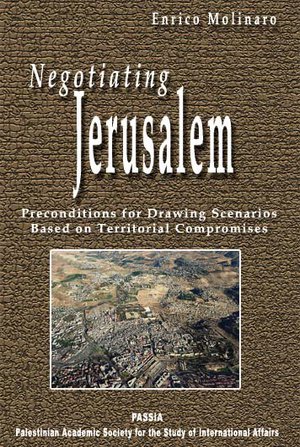Negotiating Jerusalem Preconditions for Drawing Scenarios Based on Territorial Compromises
The author introduces and describes in detail two models of collec¬tive identity to explain why Israel and the PLO have decided to exclude from the framework of the interim peace agreements the discussion over the highly sensitive and strategic issue of Jerusalem until the beginning of the permanent status negotiations. The first model, the territorial/national approach, emphasizes the special impor¬tance of Jerusalem as the national capital for two warring parties. The second model follows a universalist-religious approach, stressing Jerusalem’s significance as a spiritual center for Christians, Jews and Muslims throughout the world. The author further discusses problems of terminology and suggest creative proposals for the negotiators.
Introduction
I. THE TERRITORIAL/NATIONAL-ORIENTED APPROACH PREVAILING DURING THE OSLO NEGOTIATIONS
I.1 Ancient Rome and Modern Europe: From a Flexible Combination to an Exclusive Cyclical Dichotomy of Territorial and Personal Jurisdiction?
I.2 The European State's Model of Exclusive Territorial Sovereignty. Legal-Historical Background of the Term and Practical Distinction to its Three Different Aspects: Independence, Authority and Title
I.3 The Limits in International Practice of the Described Model: Functional, Personal and Territorial Jurisdiction
II. JERUSALEM AS A SPECIAL ISSUE POSTPONED UNTIL THE COMMENCEMENT OF PERMANENT STATUS NEGOTIATIONS: THE UNIVERSALIST/ RELIGIOUS DIMENSION OF JERUSALEM ANDTHE STATUS QUO IN THE HOLY PLACES
II.1 The Different Meanings of 'Status Quo' in Jerusalemand the Political/Territorial Status Quo
II.2 The Original Overlapping of Personal and Territorial Jurisdiction in the Ottoman Empire
The Holy Places of Jerusalem and the Capitulations
The Millet System
II.3 The Status Quo in the Holy Places in the Narrow Sense
a.Origins of the Christian Holy Places' Status Quo
b.The Status Quo's Extension to the Jewish-Muslim Holy Places
c.The Settlement of Disputes on the Rights and Claims in Connection with the Holy PlacesAccording to the Mandate's Provisions
d.The Status Quo System of Law
II.4 The Cultural/Religious Status Quo
II.5 The Wider Context of the Human Right of Freedomof Religion and Worship
III. CREATIVE PROPOSALS FOR THE NEGOTIATORS
III.1 The Model of Exclusive 'Sovereignty' of the State Within its Territorial Boundaries and its Practical Distinction to the Three Different Aspects: Authority, Title, and Independence
III.2 The Status Quo of the Holy Places: Suggesting
Technical Solutions
The Status Quo System of Law
Policy Options for the Settlement of Disputes
REFERENCES
ANNEXES
Annex 1
The Terms of Mandate for Palestine [Excerpts], July 24, 1922
Annex 2
The Palestine (Holy Places) Order in Council, 1924
Annex 3
The Status Quo in the Holy Places, [Excerpts] By L.G. Cust
Annex 4
Israel's Draft Resolution on Jerusalem, Submitted to the General Assembly of the United Nations on 25 November 1949
Annex 5
Memorandum of Their Beatitudes the Patriarchs and of the Heads of the Christian Communities in Jerusalem on the Significance of Jerusalem for Christians November 14, 1994
Annex 6
Statement of Policy for the Protection of the Cultural/Religious Status Quo
Annex 7
Letter sent on 9 December 2001 by His Highness Prince Hassan bin Talal to the Author
Annex 8
Map of Jerusalem Municipal Boundaries, 1947-2000
Annex 9
Pictures of the Holy Places Affected by the Status Quo (see Annex 3)

